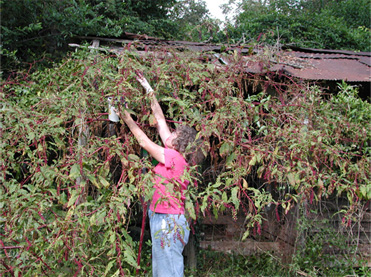|
|
Dyeing Wool With Rhododendron Leaves
Elizabeth has a number of pots and jugs of colored liquids. The rhododendron leaves dyeing instructions recommended that the leaves be processed in well ventilated area. The burn pile of sticks slowly disappeared as she first boiled the leaves and then simmered the wool. The color was a brassy yellow. Later some of the wool was modified with copper for a greenish wool and iron for dark wool.
|
Dyeing Cotton With Easter Egg Dye
Elizabeth is beaming as she holds a skein of cotton/acrylic yarn which she just dyed using Easter egg dye. The yarn was wound into a large loop, tied to keep the strands in order and then soaked in water. After painting on the dye solutions in a rainbow pattern, the dye was set in the microwave. The skein yarn was used to make a pair of rather colorful socks on her sock-knitting machine. The color has faded to soft pastels after a number of washings.
|
|
|
Elizabeth discusses natural dyeing of fibers at a fiber festival in Asheville, NC in 2004
|

Pokeberries
When we were restoring the property in Byron, we noticed a small shed at the back of the property. We later found out it was an old cow barn that dated back to at least the mid 1900s. Jim was anxious to clean up the area and get rid of all the weeds, then Elizabeth noticed that those weeds were some excellent pokeberry plants. The clean up had to wait until the crop was harvested. Pokeberry "should" give a lovely magenta color. The dyeing of the wool is on the list of warm weather projects.
|
Click HERE to see one of Elizabeth's dyeing class at John C. Campbell Folk School.
|